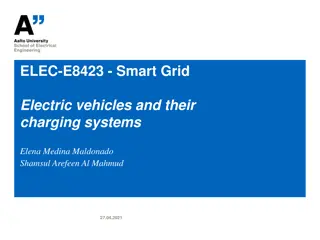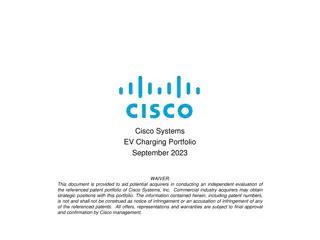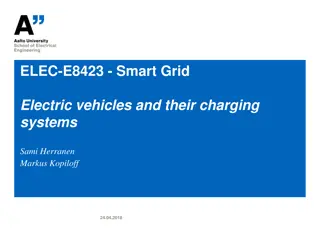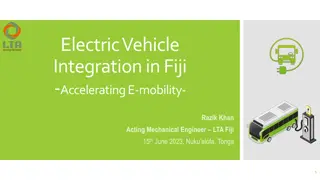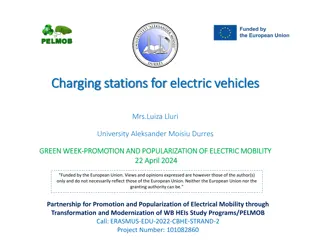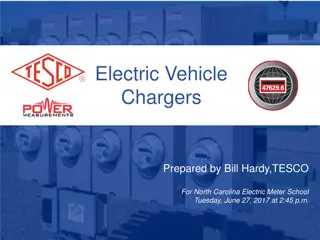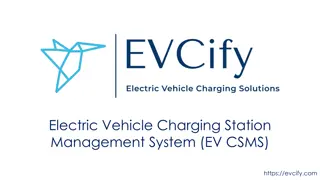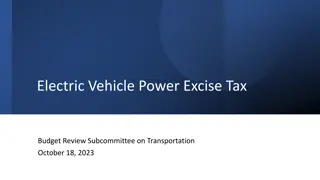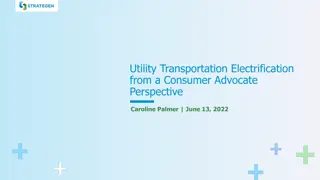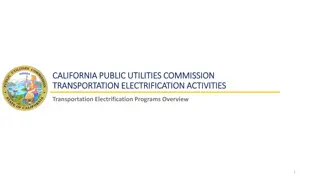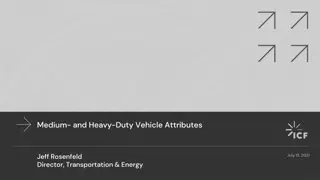UK's Strategic Approach to Electric Vehicle Charging Infrastructure
The UK is a leader in electric vehicle adoption, with a significant increase in battery electric cars and a growing public charging network. Despite progress, challenges such as consumer experience, charging for long journeys, and slow local rollout exist. The Infrastructure Strategy aims to address these by leveling up on-street public chargepoints, accelerating the rapid charging network, regulating for open access and reliability, fostering innovation, and integrating with the energy system.
Download Presentation

Please find below an Image/Link to download the presentation.
The content on the website is provided AS IS for your information and personal use only. It may not be sold, licensed, or shared on other websites without obtaining consent from the author. Download presentation by click this link. If you encounter any issues during the download, it is possible that the publisher has removed the file from their server.
E N D
Presentation Transcript
The UK is a leader in the electric vehicle transition Dec 2019: Less than 2% of new cars battery electric Dec 2021: over 25% of new cars battery electric There are now over 750,000 plug-in vehicles in the UK. The UK has more fast chargers for every 100 miles of key strategic road than any country in Europe.
We have a thriving home charging market and the public network is growing fast Current charging demand from electric vehicles Home 10% 15% Work Public chargepoints 75% On average, over 600 new public chargepoints are added to the UK s roads each month, of which over 100 are rapid. The vast majority of drivers do most of their charging at home. We expect this to continue. Source: Element Energy for National Grid (2019): Electric Vehicle Charging Behaviour Study
but there are a number of challenges to delivering this vision. 1. Consumer experience 3. Charging for long journeys 2. Pace of rollout Local rollout is too slow, with patchy provision of on-street charging for people without home charging. Chargepoints can be difficult to use, unreliable and require multiple apps and smartcards. Connecting new on-route chargepoints can be slow and costly and the current MSA offer is poor.
The Infrastructure Strategy sets out our strategic approach to tackling these challenges #1: Levelling up provision of on-street public chargepoints, including a 500m infrastructure package, and potential powers for an obligation on local authorities to develop plans. Supporting the accelerated rollout of a comprehensive rapid charging network on major roads, including delivery of the 950m Rapid Charging Fund. Allow thriving sectors to flourish: The destination and home charging markets are flourishing. For these parts of the market, Government s role is to address the practical barriers to rollout.
The Infrastructure Strategy sets out our strategic approach to tackling these challenges #2: 3. Regulate where needed to make sure chargepoints are open access, reliable and easy to use e.g. by requiring a minimum payment method, such as contactless. 5. Continued innovation, supporting new technology and business models that deliver the EV transition and a thriving UK sector, ripe for growth and export. 4. Integrate with the energy system so charging is smart and makes the most efficient use of the electricity system.
The 10m Local EV Infrastructure Pilot is available to local authorities in England. The pilot will... Increase consumer confidence in transitioning to EVs across England, ensuring increased uptake across regions. Leverage additional private sector investment and promote sustainable business models to enable the delivery of local chargepoint projects that would not occur in the near-term without public support. Test innovative technologies and business models. Help enable strategic local provision of publicEVinfrastructure ahead of need and promote an equitable EVcharging expe rience for those without off- street parking. For more information contact the support provider, Energy Saving Trust, at LEVI@est.org.uk
Key 9 commitments (out of 18 in strategy) Regulate to make sure public chargepoints are reliable and easy to use Summer 2022 Legislation will be introduced later in 2022 to improve people s experience when using public chargepoints. Improve accessibility at public chargepoints for disabled users working in partnership with Motability; develop charging standards. Summer 2022 Support local government to deliver chargepoint strategies and rollout of public on-street chargepoints Provide local authorities with grant funding through the On-Street Residential Chargepoint Scheme. Ongoing Provide expert support, through the Local Government Support Programme, to local authorities seeking to develop chargepoint strategies, procure chargepoints and apply for funding. Launch the 10m Local EV Infrastructure (LEVI) pilot project to demonstrate at-scale local deployment. Invest at least 500m to support local authorities to plan and deliver local public charging infrastructure: the 450 million Local EV Infrastructure (LEVI) fund, the On-street Residential Chargepoint Scheme, and up to 50m to fund the staff needed to do this work, and the supporting knowledge and tools to help them to work out their specific local challenges and plan accordingly. Ongoing Spring 2022 2022-2025 Accelerate the rollout of a comprehensive and competitive rapid charging network on major roads Work with the private sector to ensure there are at least six high powered chargepoints at each motorway service area Consult on the design of the 950 million Rapid Charging Fund. This fund will support the rollout of at least 6,000 high powered chargepoints across England s motorways and major A-roads by 2035, by enabling electricity network infrastructure to be installed ahead of chargepoint demand. Launch pathfinder projects for the Rapid Charging Fund, ahead of the fund opening in 2023. End 2023 Summer/Autumn 2022 Autumn 2022


